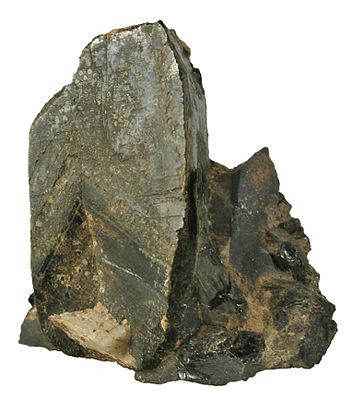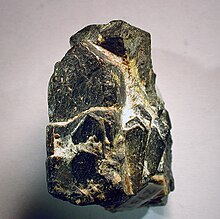Samarskite- (Y)
| Samarskite- (Y) | |
|---|---|
| Samarskit- (Y) from Setesdal , Aust-Agder, Norway (size: 4.6 × 4.6 × 3.0 cm) | |
| General and classification | |
| other names |
|
| chemical formula |
|
|
Mineral class (and possibly department) |
Oxides and hydroxides |
|
System no. to Strunz and to Dana |
4.DB.25 ( 8th edition : IV / D.10b) 01/08/11/01 |
| Crystallographic Data | |
| Crystal system | orthorhombic |
| Crystal class ; symbol | orthorhombic-dipyramidal; 2 / m 2 / m 2 / m |
| Space group | Pbcn (No. 60) |
| Lattice parameters | a = 4.92 Å ; b = 5.69 Å; c = 5.21 Å |
| Formula units | Z = 2 |
| Physical Properties | |
| Mohs hardness | 5 to 6 ( HV = 736 to 897) |
| Density (g / cm 3 ) | measured: 5.0 to 5.69; calculated: 6.28 |
| Cleavage | indistinct after {010} |
| Break ; Tenacity | clamshell; brittle |
| colour | velvety black, brown to yellow-brown due to weathering |
| Line color | dark reddish brown to black |
| transparency | opaque, transparent in thin fragments |
| shine | Glass gloss to resin gloss |
| radioactivity | very radioactive |
Samarskite- (Y) (short Samarskite ) is a rather seldom occurring mineral from the mineral class of the "oxides and hydroxides" with the idealized chemical composition YFe 3+ Nb 2 O 8 and thus an yttrium - iron - niobium - oxide .
Samarskite- (Y) crystallizes in the orthorhombic crystal system , but mostly develops only coarsely crystalline to coarse mineral aggregates , but rarely also tabular to prismatic crystals , which are stretched along the c-axis and can reach a size of 12 cm.
The mineral is generally opaque and only transparent in thin fragments. The surfaces of visible crystal surfaces have a glass-like to resin-like sheen , while coarse aggregates are matt. Fresh Samarskite samples are velvety black in color with a brownish tinge. In the transmitted light microscope , on the other hand, the mineral appears light to dark brown and weathering causes samarskite to gradually turn brown to yellowish brown. Its line color , on the other hand, is dark reddish brown to black, which, however, also turns gray due to weathering.
Etymology and history
The mineral was named after its discoverer, the Russian Montanist Wassili Evgrafowitsch Samarski-Bychowez (1803-1870), who worked in the corps of Russian mining engineers (1861-1870 chief). The mineral name was given in 1847 at the suggestion of the German mineralogist Heinrich Rose . In the older literature, the names uranium tantalum (after Gustav Rose ) and yttroilmenite (after RI Herman) are also recorded for samarskite . The type locality is the “Blyumovskaya” pit (shaft no. 50) on Mount Ilmen in the “Ilmen Nature Reserve” in the Russian Oblast of Chelyabinsk (Southern Urals).
The mineral samarskite plays an important role in scientific research into the lanthanide group. The relatively large quantities of this mineral available allowed extensive analysis. Marc Delafontaine discovered in 1878 with the spectral analysis the inconsistency of the didymoxide obtained from it . Lecoq de Boisbaudran isolated the samarium oxide from samarskite in 1879. Marignac was in 1880 alongside of him samarium and the gadolinium extract.
classification
Already in the outdated but still partially in use 8th edition of the mineral classification by Strunz "MO of Samarskit the mineral class of" oxides and hydroxides "and then to the department belonged to two - and related compounds" where he along with Euxenite , Fersmit , Ishikawait , Kobeit , Loranskit , Polykras , Tantalpolykras (Q), Tanteuxenit , Yttrokrasit- (Y) and Yttrotantalit the " Euxenit series" with the system no. IV / D.10b .
In the last revised and updated Lapis mineral directory by Stefan Weiß in 2018 , which, out of consideration for private collectors and institutional collections, is still based on this classic system of Karl Hugo Strunz , the mineral was given the system and mineral number. IV / D.19-60 . In the "Lapis system" this corresponds to the section "Oxides with the ratio metal: oxygen = 1: 2", where Samarskite- (Y) together with Calciosamarskite , Euxenite- (Y) , Fersmit, Ishikawaite , Loranskite- (Y) , Písekit- (Y) (Q), Polykras- (Y) , Samarskit- (Yb) , Tanteuxenit- (Y) , Uranopolykras , Yttrocolumbit- (Y) , Yttrokrasit- (Y), Yttrotantalit- (Y) an independent, but forms unnamed group.
The 9th edition of Strunz's mineral systematics , valid since 2001 and updated by the International Mineralogical Association (IMA) until 2009, also assigns the Samarskite- (Y) to the oxides division with the ratio “metal: oxygen = 1: 2 and comparable " a. However, this is further subdivided according to the relative size of the cations involved and the crystal structure , so that the mineral is classified in the sub-section “With medium-sized cations; Chains edge-linked octahedra "can be found, where it is named" Samarskitgruppe "with the system no. 4.DB.25 and the other members calciosamarskit, ishikawait, ixiolit , písekit- (Y), samarskit- (Yb), srilankit and yttrocolumbit- (Y).
The systematics of minerals according to Dana , which is mainly used in the English-speaking world , assigns the Samarskite- (Y) to the class of "oxides and hydroxides", but there in the more finely subdivided section "multiple oxides with Nb, Ta and Ti". Here he is only together with Samarskite- (Yb) in the " Samarskit group " with the system no. 08.01.11 can be found in the subsection "Multiple oxides with Nb, Ta and Ti with the formula ABO 4 ".
Crystal structure
Samarskite- (Y) crystallizes orthorhombically in the space group Pbcn (space group no. 60) with the lattice parameters a = 4.92 Å ; b = 5.69 Å and c = 5.21 Å and 2 formula units per unit cell .
properties
The mineral is classified as highly radioactive due to its uranium content of up to 15.9% and has a specific activity of around 28.74 k Bq / g (for comparison: natural potassium 31.2 Bq / g).
Education and Locations
Samarskite- (Y) forms as a rare, accessory component in granite - pegmatite ducts with a high proportion of rare earth metals .
There it occurs in paragenesis with albite , aschynite , beryl , biotite , columbite , garnet , magnetite , monazite , muscovite , topaz , tourmaline , uraninite and zircon as well as ore minerals such as cassiterite and tantalite (Mn) .
At the site of the first discovery, Bljumowskaja kop 'in the southern Illmen Mountains (near Miass), the samarskite was found in adhesions with columbite . The Illmen Mountains are part of the Southern Urals and are located about 200 km south of Yekaterinburg . The Bljumowskaja mine (Bljumowskaja kop ') was built in 1835 and is known as a rich mineral discovery site in the southern Urals. Here in 1911 during the radium expedition of Vernadsky's employees, around 15 kilograms of samarskite were recovered and passed on to Marie Skłodowska-Curie for examination .
As a rather rare mineral formation, Samarskite- (Y) can sometimes be abundant at different sites, but overall it is not very common. Worldwide, around 350 sites are known to date (as of 2012). In addition to its “Blyumovskaya” mine type locality, the mineral was found in other places on Mount Ilmen and the nearby Miass River in the Urals, as well as at two sites in the East Siberian Republic of Buryatia .
In Germany, Samarskit- (Y) was found near Matzersdorf and Stützersdorf in the municipality of Tittling and near Hadendorf in the municipality of Waidhaus in Bavaria, as well as in several places in the Eifel near Nieder mendig and at the Krufter oven.
In Austria, the mineral has to date only in the scheelite - deposit in Felbental ( Hohe Tauern ) in Salzburg and Mitter riding / Aigen im Mühlkreis up in Upper Austria. Another site, Meitschenhof in the Pregarten community , has not yet been confirmed.
The only known locality for Samarskit- (Y) in Switzerland is an abandoned granophyre - Quarry near the chapel of the Madonna in the Ticino community Carona TI .
Other locations are among others in Australia, Brazil, China, Finland, France, Guyana, India, Italy, Japan, Canada, Madagascar, Mozambique, Norway, Poland, Romania, Zambia, Saudi Arabia, Sweden, Slovakia, South Africa, the Czech Republic, Ukraine and in several states of the USA.
use
Samarskite is used as a raw material for the extraction of lanthanoid metals and for the rare transition metals niobium and tantalum .
See also
Web links
- Mineral Atlas: Samarskite- (Y) (Wiki)
- Samarskite- (Y) search results. In: rruff.info. Database of Raman spectroscopy, X-ray diffraction and chemistry of minerals (RRUFF), accessed on August 11, 2019 .
Individual evidence
- ↑ a b c d Synonyms of Samarskite- (Y). In: mindat.org. Hudson Institute of Mineralogy, accessed August 11, 2019 .
- ↑ a b Malcolm Back, William D. Birch, Michel Blondieau and others: The New IMA List of Minerals - A Work in Progress - Updated: May 2019. (PDF 1713 kB) In: cnmnc.main.jp. IMA / CNMNC, Marco Pasero, July 2019, accessed August 11, 2019 .
- ↑ a b c d Hugo Strunz , Ernest H. Nickel : Strunz Mineralogical Tables. Chemical-structural Mineral Classification System . 9th edition. E. Schweizerbart'sche Verlagbuchhandlung (Nägele and Obermiller), Stuttgart 2001, ISBN 3-510-65188-X , p. 209 (English).
- ↑ a b David Barthelmy: Samarskite- (Y) Mineral Data. In: webmineral.com. Accessed August 11, 2019 .
- ↑ a b c d Samarskite- (Y) . In: John W. Anthony, Richard A. Bideaux, Kenneth W. Bladh, Monte C. Nichols (Eds.): Handbook of Mineralogy, Mineralogical Society of America . 2001 (English, handbookofmineralogy.org [PDF; 72 kB ; accessed on August 11, 2019]).
- ↑ a b Samarskite- (Y). In: mindat.org. Hudson Institute of Mineralogy, accessed August 11, 2019 .
- ↑ Heinrich Remy: Textbook of Inorganic Chemistry . tape 2 . Geest & Portig, Leipzig 1973, DNB 730292169 , p. 661 .
- ↑ Stefan Weiß: The large Lapis mineral directory. All minerals from A - Z and their properties. Status 03/2018 . 7th, completely revised and supplemented edition. Weise, Munich 2018, ISBN 978-3-921656-83-9 .
- ↑ Ernest H. Nickel, Monte C. Nichols: IMA / CNMNC List of Minerals 2009. (PDF 1703 kB) In: cnmnc.main.jp. IMA / CNMNC, January 2009, accessed April 25, 2019 .
- ↑ Peter Kolesar, Jaromir Tvrdý: Tsar Treasures . 1st edition. Rainer Bode, 2006, ISBN 978-3-925094-87-3 , pp. 298 u. 321 .
- ↑ Find location list for Samarskit- (Y) at the Mineralienatlas and at Mindat


